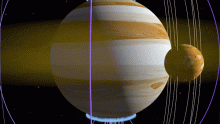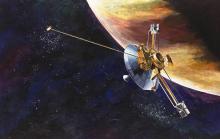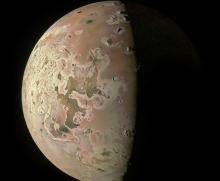Listen to today's episode of StarDate on the web the same day it airs in high-quality streaming audio without any extra ads or announcements. Choose a $8 one-month pass, or listen every day for a year for just $30.
You are here
Moon and Jupiter
Ancient skywatchers gave the planets personalities. Jupiter, for example, represented the king of the gods of Olympus, with all the qualities that suggests — strength and courage, among others. If the modern world associated the planets with heroic beings, it might still be Olympians — but of the athletic kind. Mercury might be a sprinter, and Saturn a marathoner. And Jupiter would be king of the shot-put.
Jupiter is the giant of the solar system — it’s more massive than all the other planets put together. That gives it a powerful gravitational field, which has a big influence on the space around it.
When the solar system was young, it was filled with billions of small chunks of rock and ice known as planetesimals — the building blocks of the planets. Jupiter’s gravity ejected many of them from the solar system, into deep space. Jupiter also pushed around planetesimals in a broad band between Jupiter and Mars, preventing them from forming a planet. Today, that band is the asteroid belt.
Jupiter continues to push around smaller bodies even now. Encounters with comets or asteroids can shove them into different orbits. It can even kick them out of the solar system entirely — long-distance shot-puts for a true Olympian.
Jupiter rises quite close to the Moon in the wee hours of the morning, and is above the Moon at first light. It looks like a brilliant star. The planet Saturn is nearby, and we’ll have more about that tomorrow.





